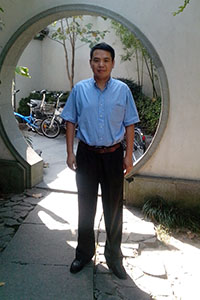- Details
-
Category: Department News
-
Published: Friday, August 12 2016 11:16
Nobel laureate Frank Wilczek of the Massachusetts Institute of Technology has been named the 2016 recipient of the Richard E. Prange Prize and Lectureship in Condensed Matter Theory and Related Areas. Dr. Wilczek will receive a $10,000 honorarium and deliver a public lecture entitled "Some Intersections of Art and Science” at the University of Maryland, College Park, on September 20, 2016. He will also present a Condensed Matter Theory Center/Joint Quantum Institute seminar entitled “Anyons” on Monday, September 19.
The Prange Prize, established by the UMD Department of Physics and Condensed Matter Theory Center (CMTC), honors the late Professor Richard E. Prange, whose distinguished professorial career at Maryland spanned four decades (1961-2000). The Prange Prize is made possible by a gift from Dr. Prange's wife, Dr. Madeleine Joullié, a Professor of Chemistry at the University of Pennsylvania.
As a Ph.D. student in 1973, Wilczek and his Princeton advisor David Gross discovered asymptotic freedom, which holds that the closer quarks are to each other, the weaker the interaction (color charge) between them; in extreme proximity, quarks behave almost as free particles. This insight helped lead to the Standard Model of particle physics. Wilczek and Gross shared the 2004 Nobel Prize in physics with David Politzer for this breakthrough. Wilczek has also received the Julius Edgar Lilienfeld Prize of the American Physical Society, the High Energy and Particle Physics Prize of the European Physical Society and the Lorentz Medal of the Royal Netherlands Academy of Arts and Sciences. He is the Herman Feshbach Professor of Physics at MIT, a Professor at Stockholm University, the Chief Scientist of the Wilczek Quantum Center of Zhejiang University of Technology, and a Distinguished Origins Professor at Arizona State University.
Wilczek’s Prange Prize lecture will be given in Room 1412 of UMD’s John S. Toll Physics Building at 4:00 p.m. on Tuesday, September 20, and is open to the public.
At the University of Chicago, Richard Prange received his Ph.D. under Nobelist Yoichiro Nambu and also worked with Murray Gell-Mann and Marvin Goldberger. At the University of Maryland, he edited a highly-respected book on the quantum Hall effect and made important theoretical contributions to the subject. His interests extended into all aspects of theoretical physics, and continued after his retirement. Dr. Prange was a member of the Maryland condensed matter theory group for more than 40 years and was an affiliate of CMTC since its inception in 2002.
"Richard enjoyed a fascinating and fulfilling career at the University of Maryland exploring condensed matter physics, and even after retirement was active in the department," said Dr. Joullié. "He spent the very last afternoon of his life in the lecture hall for a colloquium on graphene, followed by a vigorous discussion. And so I was happy to institute the Prange Prize, to generate its own robust discussions in condensed matter theory."
"The Prange Prize provides a unique opportunity to acknowledge transformative work in condensed matter theory, a field that has proven to be an inexhaustible source of insights and discoveries in both fundamental and applied physics,” said Dr. Sankar Das Sarma, who holds the Richard E. Prange Chair in Physics at UMD and is also a Distinguished University Professor and Director of the CMTC.
Since its initiation in 2009, the Prange Prize has been awarded to Nobelists Philip W. Anderson, Walter Kohn, Daniel Tsui, Andre Geim, David Gross and Klaus von Klitzing.
Parking is available in the Regents Drive Garage, across the street from the Physics lecture hall; an attendant will direct visitors within the garage. A free ShuttleUM bus runs to and from the College Park Metro station at about eight-minute intervals.
Directions to the College Park campus can be found here: http://www.cvs.umd.edu/visitors/maps.html
The John S. Toll Physics building: http://maps.umd.edu/map/index.html?&LocationType=Building&LocationName=082&Welcome=False&MapView=Detailed
University of Maryland Physics: http://umdphysics.umd.edu/ Weekly colloquia: http://www.umdphysics.umd.edu/events/physicscolloquia.html
College of Computer, Mathematical and Natural Sciences: http://www.cmns.umd.edu/
Condensed Matter Theory Center: http://www.physics.umd.edu/cmtc

